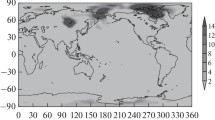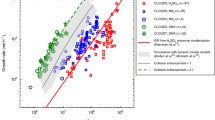Abstract
The fate of stratospheric ions was, until recently, thought to be spontaneous neutralisation following mutual recombination of oppositely charged species. According to Ferguson1–3 this need not necessarily apply for sufficiently complex cluster ions, as clustering may stabilise ions against neutralisation. Thus, if neutralisation does not occur, stable ion pairs may be formed. This possibility seemed more likely after the first simultaneous composition measurements of stratospheric positive and negative ions4–6 revealed the presence of species more stable than those predicted on theoretical grounds; this led to consideration of a possible role of ion pairs in aerosol formation7. Here the formation of ion pairs is investigated in the light of new stratospheric ion composition data. Interactions of ion pairs with other stratospheric constituents, and their significance for aerosol and trace gases is discussed and an experimental check of the existence of the hypothetical stratospheric ion pairs is suggested.
Similar content being viewed by others
References
Castleman, A. W. Nucleation and Molecular Clustering about Ions (Report, Universtiy of Colorado, Boulder, 1978).
Ferguson, E. Geophys. Res. Lett. 5, 1035 (1978).
Davidson, J. A., Fehsenfeld, F. C. & Howard, C.J. Int. J. Chem. Kinet. 9, 17 (1977).
Arnold, F., Böhringer, H. & Henschen, G. Geophys. Res. Lett. 5, 653 (1978).
Arnold, F. & Henschen, G. Nature 257, 521 (1978).
Arnold, F., Fabian, R., Henschen, G. & Joos, W. Planet. Space Sci. (in the press).
Viggiano, A. A., Perry, R. A., Albritton, D. L., Ferguson, E. E. & Fehsenfeld, F. C. J. geophys. Res. (in the press).
JANAF, Thermochemical Table (National Bureau of Standards, PB 168370, Washington DC, 1965).
Benson, W. W. Chem. Rev. 78, 23 (1978).
Cadle, R. D. & Kiang, C. S. Rev. geophys. Space Sci. 15, 195 (1977).
Mohnen, V. A. Proc. 4th Conf. CIAP (Climatic Impact Assessment Programme) 1975, 478 (US Department of Transportation, 1975).
Arnold, F. & Fabian, R. Nature 283, 55 (1980).
Dickinson, R. E. Bull. Am. met. Soc. 56, 1240 (1975).
Smith, D. & Church, M. J. Planet. Space Sci. 25, 433 (1977).
Crutzen, P. J. J. geophys. Res. 3, 73 (1976).
Arnold, F., Henschen, G., Fabian, R. & Joos, W. Planet. Space Sci. (submitted).
Kebarle, P. A. Rev. phys. Chem. 28, 445 (1977).
Fehsenfeld, F. C., Howard, C. J. & Schmeltekopf, A. L. J. chem. Phys. 63, 2835 (1975).
Author information
Authors and Affiliations
Rights and permissions
About this article
Cite this article
Arnold, F. Multi-ion complexes in the stratosphere—implications for trace gases and aerosol. Nature 284, 610–611 (1980). https://doi.org/10.1038/284610a0
Received:
Accepted:
Issue Date:
DOI: https://doi.org/10.1038/284610a0
- Springer Nature Limited
This article is cited by
-
Exploration of superhalogen nature of Pt(CN)n complexes (n = 1–6) and their abilities to form supersalts and superacids: a DFT–D3 study
Structural Chemistry (2021)
-
Energetic Particle Influence on the Earth’s Atmosphere
Space Science Reviews (2015)
-
Role of sulphuric acid, ammonia and galactic cosmic rays in atmospheric aerosol nucleation
Nature (2011)
-
Atmospheric Ions and Aerosol Formation
Space Science Reviews (2008)
-
Atmospheric Ion-induced Aerosol Nucleation
Space Science Reviews (2007)





